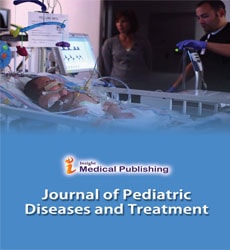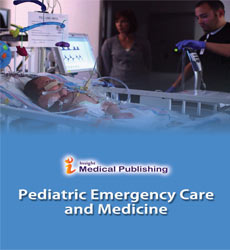A Rare Case of a Medulla Oblongata Brain Abscess in a 23-Month-Old Child
Walter Wiswell, Katie Jerzewski and Melissa McGuire
Walter Wiswell1*, Katie Jerzewski2 and Melissa McGuire3
1Department of Emergency Medicine, Hofstra/Northwell Health, New York, United States
2Department of Pediatric Medicine, Children’s Hospital at Montefiore, New York, United States
3Department of Medicine, Donald and Barbara Zucker School of Medicine at Hofstra/Northwell, New York, United States
- *Corresponding Author:
- Wiswell W
Emergency Medicine Resident, Hofstra/Northwell Health, New York, United States
Tel: 904-434-6281
E-mail: wtwiswell@gmail.com
Received Date: December 30, 2018; Accepted Date: January 07, 2019; Published Date: January 15, 2019
Citation: Wiswell W, Jerzewski K, McGuire M (2019) A Rare Case of a Medulla Oblongata Brain Abscess in a 23-Month-Old Child. Pediatr Emerg Care Med Open Access. Vol.4 No.1:01.
Copyright: © 2019 Wiswell W, et al. This is an open-access article distributed under the terms of the Creative Commons Attribution License, which permits unrestricted use, distribution, and reproduction in any medium, provided the original author and source are credited.
Abstract
Background: While intracranial abscesses represent a rare yet serious infectious risk in the pediatric population, those collections limited to the brainstem are even rarer still. We report the clinical presentation and hospital course of a brainstem abscess isolated to the medulla oblongata of a 23-month-old child.
Case/Findings: This abscess initially presented with a non-specific constellation of symptoms including fever, diarrhea, and listlessness, and was diagnosed via magnetic resonance imaging (MRI) only after the patient spent three days in the hospital without showing signs of significant clinical improvement back to baseline. She then underwent incision and drainage by neurosurgery and a prolonged antibiotic course, with eventual complete resolution of the collection more than one month after initial presentation.
Conclusion: This is a case of exceptional rarity, due to the scarcity of documented intracranial abscesses isolated to this region. In addition, this case offers insight into the need to include intracranial infectious pathology on the differential diagnosis of a patient with nonspecific symptoms associated with an altered mental status.
Keywords
Medulla oblongata; Magnetic resonance imaging; Prolonged antibiotic course
Introduction
Intracranial abscesses, defined by an intraparenchymal collection of pus, represent a serious infectious cause of morbidity and mortality in all ages, especially in developing countries and in the immunocompromised [1]. However, while abscesses have continued to be a leading cause of brain masses, such lesions within the brainstem itself are extremely rare, encompassing only 4% of all total posterior fossa masses, and only 1% total of all intracranial abscesses [2]. Despite their infrequency, mortality rates are significantly higher in patients with brainstem collections in comparison to abscesses of the cerebrum or cerebellum [3]. Prior to 1974, all brainstem abscesses were considered lethal, with no reported instances of survival.
Since 1974, only 20 reported instances of successfully treated pediatric brainstem abscesses are documented. While the most common abscess locations were the pons and midbrain, those isolated to the medulla oblongata are exceeding rare in the pediatric population [4-7]. Of the aforementioned cases, only 4 have included the medulla, and only 2 have been completely isolated to the medulla oblongata. This rarity is enhanced by the the fact that as treatment of traditional pediatric paranasal and otogenic infections has improved, intracranial complications have become infrequent in pediatrics [8]. We present the third known case of an encephalopathic young child secondary to brainstem abscess isolated to the medulla oblongata.
Case and Methods
LT, an ex-full-term, previously healthy and fully vaccinated 23-month-old girl, first presented to the emergency department (ED) complaining of two days of isolated emesis of "yellow-green" mucus and decreased oral intake. She was well appearing with a normal exam and successfully tolerated clears post-ondansetron administration, and thus was discharged home. Although her emesis resolved, she represented to the ED two days later because of persistent and worsening decreased oral intake associated with several hours of appearing more tired than baseline.
On exam, she was febrile (38.1C, rectal) and listless but arousable, falling asleep in the triage bay and examination room. Her neck was supple without meningismus, and she no other focal neurological deficits. Her oropharynx was erythematous with tonsillar swelling, but she had a patent airway and brisk capillary refill. Her exam was otherwise non-contributory. Labs showed a pH of of 7.37, sodium 126, chloride 87, bicarbonate 19, WBC 22.7 (19% neutrophils, 1.7% monocytes), and lactate 2.5. Rapid strep testing was negative. Urinalysis showed mild glucosuria (250) and proteinuria (30 mg/dL), but a normal specific gravity and no signs of infection. Serum and urine toxicology screens were negative. After two 20 mL/kg normal saline boluses, her electrolytes remained abnormal (sodium 129, chloride 89), but she became more awake and alert, interacting with her mother and sitting normally and unassisted. She also began to drink small amounts of clears. A plan was made to admit given her mental status and persistent electrolyte abnormalities.
Approximately two hours later, while still in the ED, she had a generalized six minute febrile seizure requiring one dose of Ativan. A CT head was obtained due to the atypical nature of her presentation, which was read as negative. A lumbar puncture (LP) was performed, and ceftriaxone, vancomycin and acyclovir were started given the grossly cloudy appearing cerebrospinal fluid (CSF) obtained.
Cell count and gram stain ultimately showed elevated protein, low glucose, and mild pleocytosis (589) but with no organisms. The patient was admitted to the PICU where her mental status, although improved from ED arrival did not returned to baseline despite negative blood, urine, and CSF culture/gram stain.
Neurology and ID were consulted; acyclovir was discontinued due to negative Herpes Simplex Virus testing and an EEG was normal. In the setting of negative CSF cultures and continued symptoms, a brain MRI was obtained (hospital day (HD3), demonstrating significant regional vasogenic edema of the brainstem and cervical spinal cord with a 11 mm × 10 mm cervicomedullary abscess. She underwent Incision and Drainage via C1 laminectomy by neurosurgery the next day (HD4).
Despite extension of her vasogenic edema into the cervical region, no additional evidence of cervical abscess presence or continuation was discovered during surgery or on subsequent additional imaging (Figure 1).
Aspiration cultures taken during the procedure grew Streptococcus intermedius. LT's neurological exams returned to a normal baseline after surgery, and she was maintained on a six week post-drainage ceftriaxone course.
Follow-up imaging demonstrated initial improvement in the size of the remaining abscess, but interval increase in the peri-brainstem edema on post-operative day (POD) 11. There was subsequent complete resolution of the abscess and minimal remaining edema on POD36.
Discussion
Past literature and case reports have widely agreed with a basic division of infectious etiologies of brainstem abscesses first established by Weikhardt and Davis in their seminal 1964 study of brainstem [9]. In one-third of patients, infection to the brainstem was through a hematogenously spread from a primary infected source. These sources could be as proximatel as the teeth, or as distant as intra-abdominal structures such as the lungs or spleen. Another third of these abscesses were a result of direct invasion from proximal structures (e.g., otic/ nasal sinuses) or via open/penetrating wounds to the area. In contrast, the final third of patients had no identifiable primary source of infection leading to their brainstem abscess. Although LT presented with emesis, it is unclear if a gastrointestinal infection could have been the inciting event to her abscess development or if this symptom was secondary to mass effect created by the abscess itself. There was no documented history of a recent paranasal infection or ear pain, and she had no obvious rashes or abrasions by which an organism could have invaded. By all accounts, the patient had been generally healthy in the weeks leading up to the symptoms which caused her to initially present to the emergency room. The source of her abscess remains cryptogenic to date.
Despite the somewhat variable possible origins of these infectious brainstem collections, the offending organisms tend to be slightly more predictable. While a variety of bacteria may be involved, Staphylococcus, Peptostreptococcus, and Streptococcus species are found most commonly in pediatric brain abscesses; the latter predominating as in LT’s case. S. intermedius specifically has a known association with abscess formation, both in the brain and throughout the rest of the body. It has been estimated that S. intermedius is found in upwards of 50-80% of all brain abscesses, including both single-isolate and polymicrobial growths [10-12].
Conclusion
Although intracranial abscesses are uncommon, their effects can be significantly injurious to the patient. This case demonstrates that a non-specific constellation of symptoms associated with altered mental status should alert a clinician to include these intracranial infections in their differential diagnosis in order to ensure vigilant monitoring and prompt initiation of antimicrobial coverage.
References
- Mishra AK, Fournier PE (2013) The role of Streptococcus intermedius in brain abscess. European Journal of Clinical Microbiology & Infectious Diseases 32: 477-483.
- Russell JA, Shaw MD (1977) Chronic abscess of the brain stem. Journal of Neurology, Neurosurgery & Psychiatry 40: 625-629.
- Suzer T, Coskun E, Cirak B, Yagci B, Tahta K (2005) Brain stem abscesses in childhood. Child's Nervous System 21: 27-31.
- Arzoglou V, D'angelo L, Koutzoglou M, Rocco CD (2011) Abscess of the medulla oblongata in a toddler: case report and technical considerations based on magnetic resonance imaging tractography. Neurosurgery 69: 483-487.
- Ghannane H, Laghmari M, Aniba K, Lmejjati M, Benali SA (2011) Diagnostic and management of pediatric brain stem abscess, a case-based update. Child's Nervous System, p: 1053.
- Sahbudak Bal Z, Eraslan C, Bolat E, Avcu G, Kultursay N, et al. (2018) Brain Abscess in Children: A Rare but Serious Infection. Clinical Pediatrics 57: 574-579.
- Kozik M, Ożarzewska E (1976) A solitary abscess of the medulla oblongata. European Neurology 14: 302-309.
- Muzumdar D, Jhawar S, Goel A (2011) Brain abscess: an overview. International Journal of Surgery 9: 136-144.
- Weickhardt GD, Davis RL (1964) Solitary abscess of the brainstem. Neurology 14: 918-925.
- Frazier J, Ahn E, Jallo G (2008) Management of brain abscesses in children. Journal of Neurosurgery 24: 1-10.
- Brouwer MC, Van de Beek D (2017) Epidemiology, diagnosis, and treatment of brain abscesses. Current Opinion in Infectious Diseases 30: 129-134.
- Mirzanejad Y, Stratton CW (2005) Streptococcus anginosusgroup. In: Mandell GL, Douglas RG, Bennett JE, Dolin R (eds.). Principles and practice of infectious diseases. 6th edn. Elsevier/Churchill Livingstone, Philadelphia, PA, USA.

Open Access Journals
- Aquaculture & Veterinary Science
- Chemistry & Chemical Sciences
- Clinical Sciences
- Engineering
- General Science
- Genetics & Molecular Biology
- Health Care & Nursing
- Immunology & Microbiology
- Materials Science
- Mathematics & Physics
- Medical Sciences
- Neurology & Psychiatry
- Oncology & Cancer Science
- Pharmaceutical Sciences

